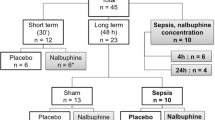Summary
The effect of naloxone (4.4–5.9 mg i.v.) was evaluated in 10 patients with circulatory shock (sepsis,n=7; intoxication,n=1; cardiogenic shock,n=2) not responding to full conventional therapy. In addition, we measured plasma ACTH and immunoreactive β-endorphin before and 60 min after administration of naloxone and compared the results with hormone concentrations in 10 intensive care patients without shock. Only in two patient with septic shock a transient increase (duration 15 min and 60 min, respectively) of systolic blood pressure was observed, while naloxone was ineffective in the remaining eight patients. No adverse effects of naloxone were found. Plasma ACTH and immunoreactive β-endorphin concentrations in patients with shock were not different from those in controls (ACTH, 79±28 vs 120±60 pg/ml; immunoreactive β-endorphin, 952±262 vs 1,070±378 pg/ml).
Our findings suggest that naloxone in a single dose of 4.4–5.9 mg i.v. does not improve the management of circulatory shock unresponsive to conventional treatment. β-endorphin seems to play no major role in the hypotension of shock.
Similar content being viewed by others
Abbreviations
- ACTH:
-
Adrenocorticotrophic hormone
- HD:
-
intermittent hemodialysis
- HF:
-
heart rate
- ir:
-
immunoreactive
- RRsyst :
-
systolic blood pressure
References
Allolio B, Winkelmann W, Hipp FX (1981) Effect of meclastine, an H1-antihistamine, on plasma ACTH in adrenal insufficiency. Acta Endocrinol (Kbh) 96:98–102
Bernton EW, Long JB, Holaday JW (1985) Opioids and neuropeptides: mechanisms in circulatory shock. Fed Proc 44:290–299
Bonnet F, Bilaine J, Lhoste F, Mankikian B, Kerdelhue B, Rapin M (1985) Naloxone therapy of human septic shock. Crit Care Med 13:972–975
Curtis MT, Lefer AM (1980) Protective actions of naloxone in hemorrhagic shock. Am J Physiol 239:H416-H421
De Maria A, Craven DE, Heffernan JJ, McIntosh TK, Grindlinger GA, McCabe WR (1985) Naloxone versus placebo in treatment of septic shock. Lancet I:1363–1365
Dirksen R, Otten MH, Wood GJ, Verbaan CJ, Haalebos MMP, Verdouw PV, Nijhuis GMM (1980) Naloxone in irreversible shock. Lancet II:1360–1361
Faden AI, Holaday JW (1980) Naloxone treatment of endotoxin shock: stereospecificity of physiologic and pharmacologic effects in the rat. J Pharmacol Exp Ther 212:441–447
Faden AI, Holaday JW (1980) Experimental endotoxin shock: the pathophysiologic function of endorphins and treatment with opiate antagonists. J Infect Dis 142:229–238
Faden AI, Jacobs ThP, Holaday JW (1981) Opiate antagonist improves neurologic receovery after spinal injuny. Science 211:493–494
Groeger JS, Carlon GC, Howland WS (1983) Naloxone in septic shock. Crit Care Med 11:650–654
Guillemin R, Vargo T, Rossier J, Minich S, Ling N, Rivier C, Vale W, Bloom F (1977) β-Endorphin and adrenocorticotropin are secreted concomitantly by the pituitary gland. Science 197:1367–1369
Gurll N (1983) Naloxone in endotoxic shock: experimental models and clinical perspective. Adv Shock Res 10:63–71
Gurll NJ, Reynolds DG, Vargish T, Lechner RB (1982) Naloxone without transfusion prolongs survival and enhances cardiovascular function in hypovolemic shock. J Pharmacol Exp Ther 220:621–624
Holaday JW (1983) Cardiovascular effects of endogenous opiate system. Annu Rev Pharmacol Toxicol 23:541–594
Holaday JW, Faden AI (1980) Naloxone acts at central opiate receptors to reverse hypotension, hypothermia and hypoventilation in spinal shock. Brain Res 189:295–299
Holaday JW, Faden AI (1978) Naloxone reversal of endotoxic hypotension suggests role of endorphins in shock. Nature 275:450–451
Jeffcoate WJ, Rees LH, Lowry PJ, Besser GM (1978) A specific radioimmunoassay for human β-lipotropin. J Clin Endocrinol Metab 47:160–166
Martin WR (1976) Naloxone. Ann Intern Med 85:765–768
Peters WP, Johnson MW, Friedman PA, Mitch WE (1981) Pressor effect of naloxone in septic shock. Lancet I:529–532.
Raymond RM, Harkema JM, Stoffs WV, Emerson ThE (1981) Effects of naloxone therapy on hemodynamics and metabolism following a supralethal dosage ofEscherichia coli endotoxin in dogs. Surg Gynecol Obstet 152:159–162
Reynolds DG, Gurll NJ, Vargish T, Lechner R, Faden AI, Holaday JW (1980) Blockade of opiate receptors with naloxone improves survival and cardiac performance in canine endotoxic shock. Circ Shock 7:39–48
Rock P, Silverman H, Plump D, Kecala Z, Smith Ph, Michael JR, Summer W (1985) Efficacy and safety of naloxone in septic shock. Crit Care Med 13:28–33
Tiengo M (1980) Naloxone in irreversible shock. Lancet II:690
Vargish T, Reynolds DG, Gurll NJ, Lechner RB, Holaday JW, Faden AI (1980) Naloxone reversal of hypovolaemic shock in dogs. Circ Shock 7:31–38
Wright DJM, Philips M, Weller MPI (1980) Naloxone in shock. Lancet II:1361
Author information
Authors and Affiliations
Additional information
Supported by Landesamt für Forschung, NRW
Rights and permissions
About this article
Cite this article
Allolio, B., Fischer, H., Kaulen, D. et al. Naloxone in treatment of circulatory shock resistant to conventional therapy. Klin Wochenschr 65, 213–217 (1987). https://doi.org/10.1007/BF01715847
Received:
Accepted:
Issue Date:
DOI: https://doi.org/10.1007/BF01715847




